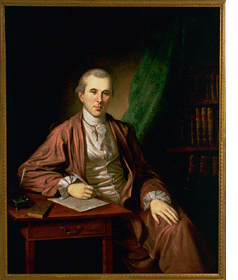
Rush was a practicing physician, energetic man of affairs, reformer and essayist, and professor of medicine and chemistry in Philadelphia. John Adams summed him up in 1775 as "an elegant, ingenious Body. Sprightly, pretty fellow. He is a Republican. . . . [He] is too much of a Talker to be a deep thinker."
Peale's portrait of Benjamin Rush characterizes him as a scholar and man of science. Rush's books are carefully labeled volumes on medicine, chemistry, electricity, political theory, moral philosophy, psychology, and the origin of languages. He is writing a lecture on the cause of earthquakes, a subject that found its way into his medical lectures. Rush's banyan was meant to indicate his studious habits. As he wrote just a few years after his portrait was painted:
Loose dresses contribute to the easy and vigorous exercise of the faculties of the mind. This remark is so obvious, and so generally known, that we find studious men are always painted in gowns, when they are seated in their libraries. . . . It is from the habits of mental ease and vigour which this careless form of dress creates, that learned men have often become contemptible for their slovenly appearance, when they mix with the world.  Title image: Terrestrial globe signed by J. & W. Cary, Courtesy Geography and Maps Division, Library of Congress/ Washington, D.C. |
 Benjamin Rush 1746-1813
Benjamin Rush 1746-1813